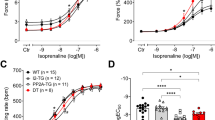Abstract.
Release-inhibiting muscarinic autoreceptors were studied in heart atria and the urinary bladder of NMRI mice, M2-receptor-deficient mice, M4-receptor-deficient mice, and wildtype mice sharing the genetic background of the knockout animals. Segments of the tissues were preincubated with 3H-choline and then superfused and stimulated electrically.
In atrial segments taken from adult mice and stimulated with 120 pulses at 1 Hz, the muscarinic receptor agonist oxotremorine-M reduced the evoked overflow of tritium. Its concentration-response curves in atria from NMRI, M2-wildtype, M4-wildtype and M2-knockout mice were similar, with maximal inhibition by about 75%. In atria from M4-knockout mice, the maximal inhibitory effect of oxotremorine-M was reduced to 57%. The concentration-response curves of oxotremorine-M were shifted to the right by ipratropium, methoctramine and pirenzepine. Methoctramine and pirenzepine were approximately equipotent antagonists in all strains except in M4-knockout atria in which methoctramine was more potent than pirenzepine. When atria from adult NMRI mice were stimulated by 360 pulses at 3 Hz, ipratropium increased the evoked overflow of tritium both in the absence and in the presence of physostigmine (0.1 µM). In atria taken from 1-day-old NMRI mice, oxotremorine-M failed to reduce the evoked overflow of tritium. In bladder segments taken from adult mice, superfused with medium containing oxotremorine-M (1 µM), and stimulated by 360 pulses at 3 Hz, ipratropium increased the evoked overflow of tritium. Its concentration-response curves in preparations from NMRI, M2-wildtype, M4-wildtype and M2-knockout mice were similar. There was one exception: ipratropium failed to cause an increase in bladder pieces from M4-knockout mice. Methoctramine and pirenzepine also increased the evoked overflow of tritium in all strains except the M4-knockout. The two antagonists were approximately equipotent in NMRI, M4-wildtype and M2-knockout preparations but methoctramine was less potent than pirenzepine in M2-wildtype preparations. When bladder pieces from adult NMRI mice were superfused with oxotremorine-M-free medium and stimulated by 360 pulses at 3 Hz, ipratropium increased the evoked overflow of tritium in the presence of physostigmine (0.1 µM) but not in its absence. In bladder segments taken from 1-day-old NMRI mice and superfused with medium containing oxotremorine-M (1 µM), ipratropium increased the evoked overflow of tritium in the same way as in adult tissue.
It is concluded that NMRI mice and the two wildtype strains are similar in their muscarinic autoreceptors. In atria, the autoreceptors are heterogeneous. Some are M4. The non-M4-autoreceptors probably are M2. In the bladder, the autoreceptors are exclusively M4. In both tissues, the autoreceptors are activated by previously released acetylcholine under appropriate conditions.
Similar content being viewed by others
Author information
Authors and Affiliations
Additional information
Electronic Publication
Rights and permissions
About this article
Cite this article
Zhou, H., Meyer, A., Starke, K. et al. Heterogeneity of release-inhibiting muscarinic autoreceptors in heart atria and urinary bladder: a study with M2- and M4-receptor-deficient mice. Naunyn-Schmiedeberg's Arch Pharmacol 365, 112–122 (2002). https://doi.org/10.1007/s00210-001-0517-7
Received:
Accepted:
Issue Date:
DOI: https://doi.org/10.1007/s00210-001-0517-7




